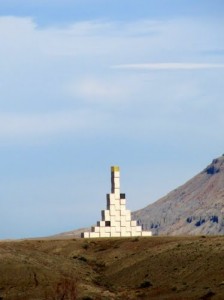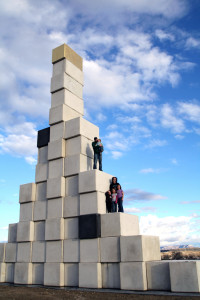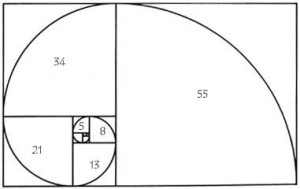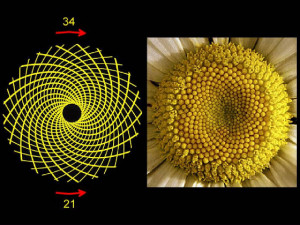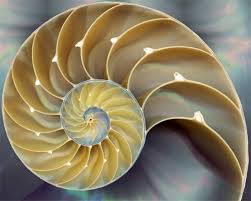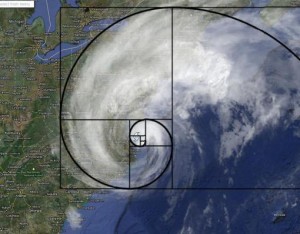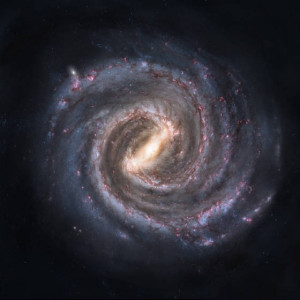While I was hiking in Utah, I ate at the Tamarisk Restaurant in Green River. On the wall by the men’s room was an explanation of the Fibonacci series and a photograph of a sculpture. I was, to say the least, curious.
The Fibonacci Sequence is the series of numbers:
0, 1, 1, 2, 3, 5, 8, 13, 21, 34, …
The next number is found by adding up the two numbers before it.
The 2 is found by adding the two numbers before it (1+1)
Similarly, the 3 is found by adding the two numbers before it (1+2),
And the 5 is (2+3),
and so on!
Here is the sculpture:
And here is an explanation:
Here in Green River, Utah we had the world renowned Australian artist Andrew Roger put together a sculpture he calls the “Golden Ratio”. It is one of three in the world. It is a pyramid of blocks created according to the mathematical rule of the golden ratio. According to Wikipedia, “In mathematics and the arts, two quantities are in the golden ratio if the ratio of the sum of the quantities to the larger quantity is equal to the ratio of the larger quantity to the smaller one.”
Golden Ratio in Math
This ratio, is also known as the divine proportion, golden mean, or golden section, is a number often encountered when taking the ratios of distances in simple geometric figures such as the pentagon. The fibonacci sequence and the golden ratio are intimately interconnected. Both are found in nature, for instance, a slice through a Nautilus shell reveals golden spiral construction principle, the length of the bones in a human finger, the number of pedals of a flower, the seemingly random sequence of sunflower seed, or the way the pine cone spines spiral on a closed pine cone.
Why the golden ratio? The golden ratio and/or fibonacci sequence is used in art and architecture all the time. These mathematical rules have a subtle aesthetic that makes most nature, art and architecture pleasing to the eye, so much so that we can’t explain it but we like it.
The sculpture can be seen from the railroad, highway and from numerous places from in town. It is an impressive structure made up of 53 blocks of enormous size (which are also based on the this ratio), two of which are black and a gold leafed block to cap the top.
Why in Green River, which has seen better days?
For 89-year-old retired Seattle school teacher and railroad buff Herbert Steiner, part of his legacy will be for financing a piece of land art called “Ratio.”
“I did it for love,” Steiner said of financing the $145,292 sculpture that sits next to Interstate 70 in Green River. “I am a writer myself, but I am not Ernest Hemingway. I was able to find one of the greatest world-famous sculptors to build it there. It was a chance at immortality. It is going to be there until God knows when. No one will remember me, but this is something that I leave that will be immortal.”
Renowned Australian artist Andrew Rogers donated his skills to designing the sculpture, which is 44 feet high and 42 feet wide and topped by a golden square.
“The Ratio” is based on the Fibonacci sequence, a mathematical concept of universal significance similar to the Golden Ratio of science and mathematics. This sequence is found in numerous patterns in nature and has been used by architects of the Parthenon, the Acropolis and Egyptian tombs.
Steiner cites his love for the Green River’s open spaces as another reason for financing the sculpture. He views “The Ratio” as a metaphor for the land around the town.
“I had a feeling of aloneness walking the land,” he said. “You could walk in four directions and there were no fences. Nobody was going to shoot you. It was unbelievable land. I love the land and that feeling of aloneness and solitude.”
Green River Mayor Pat Brady, who is also the math teacher at the town’s high school, uses the sculpture, which was assembled on a hill within sight of much of the town, to help teach mathematics to his students.
Steiner first rode an Amtrak train to the remote town of Thompson, east of Green River, 27 years ago when he was 62. Rogers is 62 and made his first trip to Utah to help with the sculpture’s installation.
Soon after taking that train trip to Thompson in the early 1980s, Steiner discovered that the Denver & Rio Grande Railroad had sold the line to Southern Pacific. That railroad’s land division was selling surplus property in Green River and Thompson at highly discounted rates.
“I bought all the land I could get, at $400 an acre,” said Steiner, who is now totally blind and lives in a Seattle apartment. “I got it cheap. The sculpture is on 100 acres that cost between $6,000 and $7,000.”
He sold some of the land to Utah State Parks for a golf course and another piece to Green River City for a sewage treatment plant. The only place where he lost money is a homestead co-op he put together in Thompson. He provided water, power and a road for 63 lots but failed to sell a single one.
One of the key players in getting the structure built was Salt Lake real estate lawyer Scott Jenkins, whom Steiner also called when looking for help with the land deals in the 1980s.
In Rogers, Steiner and Jenkins found a world-renowned artist who has conceived 350 sculptures and created the land art forms he calls “geoglyphs” in 13 countries over 13 years involving over 6,700 people. “The Ratio” is the latest of 48 large-scale stone structures Rogers has erected on all seven continents.
The structures, part of Rogers’ “Rhythms of Life” project, are found in deserts, fjords, gorges and national parks. He said these connected drawings on the surface of the earth refer to the physical building blocks of history and civilization.
“It is a group of structures in time that weave together our conduct and thoughts with the environment,” wrote the artist.
Rogers said Jenkins found him through his website and television documentaries. He took no compensation for the massive work because he feels his “Rhythms of Life” project gives him an opportunity to put out messages about values he feels are important.
He calls his works optimistic symbols of life and regeneration, of human striving and introspection. Robert Smithson, creator of the Spiral Jetty on the Great Salt Lake, was one of Rogers’ inspirations.
The fact that the site is near ancient American Indian picture glyphs and also that Rogers owned a fossil collected near Green River, even though he had not visited Utah before, also held great appeal to him.
“Ratio” was built using white cement powder imported from Canada. According to Steiner, it consists of a solid foundation of black dyed concrete on which are assembled 53 concrete blocks, each weighing 4 1/2 tons. Each block is 39-by-39-by-68 inches and is stabilized by hidden tongue-and-groove construction with two-inch rebar through the centers of the blocks. The center column consists of 13 blocks reaching 42 feet high with a gold-leafed block capping the column.
As for Steiner, he said he would love to see the sculpture for himself but imagines it as something that deals with the remoteness of the land, generating feelings of aloneness and solitude.
The Southwest is full of mysteries, and the explanation for this one could be the start of a Tony Hillerman novel.
Here is the Fibonacci spiral, and some examples from nature:
God is a mathematician.

